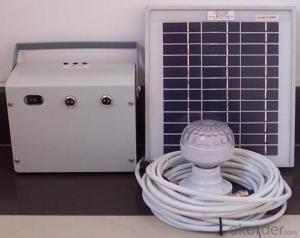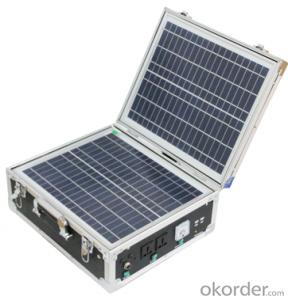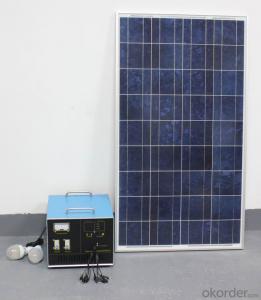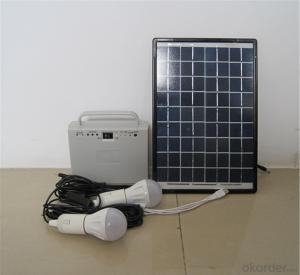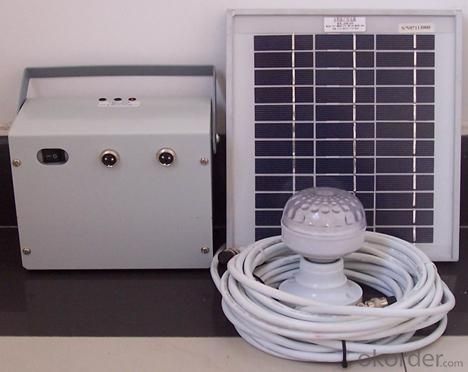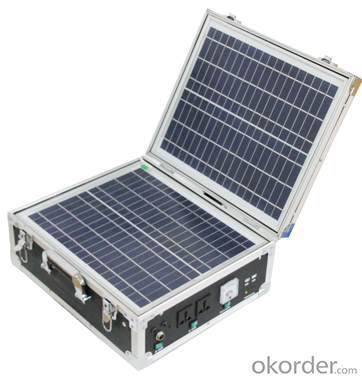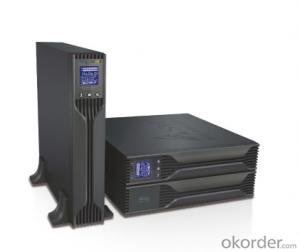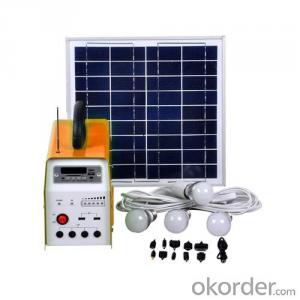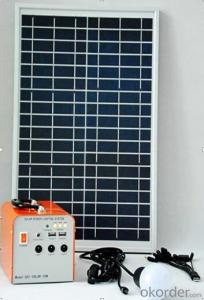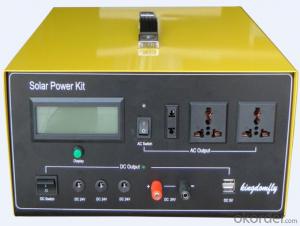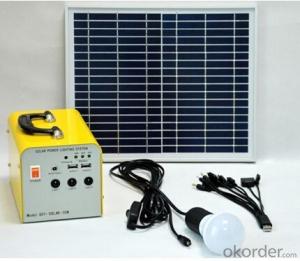Solar Energy Systems Nappanee Indiana Solar Portable System AN-S50W
- Loading Port:
- Shanghai
- Payment Terms:
- TT OR LC
- Min Order Qty:
- 0 set
- Supply Capability:
- 10000 set/month
OKorder Service Pledge
OKorder Financial Service
You Might Also Like
Specification
Description of Solar Portable System AN-S50W
Compatible portable solar power supply, also called solar mobile power, it includes: solar panel, charge controller, discharge controller, electric charge controller, inverter, outside enlarge capacity interface and battery, etc. Photovoltaic portable power supply can work in solar energy and ordinary power two modes, and can automatically switch. Photovoltaic portable power supply is used widely is the emergency relief, tourism, army, geological prospecting, archaeology, schools, hospitals, Banks, gas stations, comprehensive building, highway, substation, family camping or outdoor activities such as emergency power ideal power supply equipment.
Specifications of Solar Portable System AN-S50W
1. Solar Panel: 50W 18V
2. Battery: 12V20AH lead-acid battery
Input terminal: 1 DC input, 14.8V; 2 solar input terminal (+,-), 18V.
Output terminal: 8 output terminals, including:
1x USB output, 5V 1A;
5x DC outputs, 12V 1A;
2xAC220V outputs
Switch: 2pcs; left one for DC12V, right one for AC220V
Indication lamp: 2 pcs; Red one is for charging indication, Green one is for operating indication.
Accessories of Solar Portable System AN-S50W
1. 2pcs 3W led bulbs;
2. 1pc 5m connection wire between solar panel and cabinet;
3. 2pcs lamp holder with 3m wire;
4. 1pc AC charger
Technical Data of Solar Portable System AN-S50W
| Internal Package Size (cm) | 36*24*26 (panel extra) |
| Packing QTY | 1 |
| External Package Size (cm) | 36*24*26 (panel extra) |
IMages of Solar Portable System AN-S50W
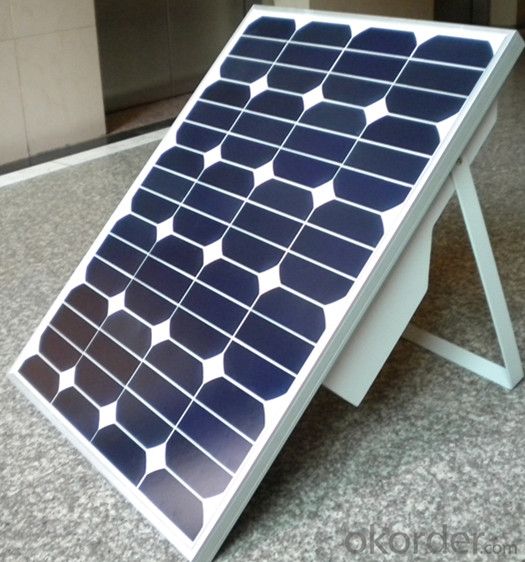

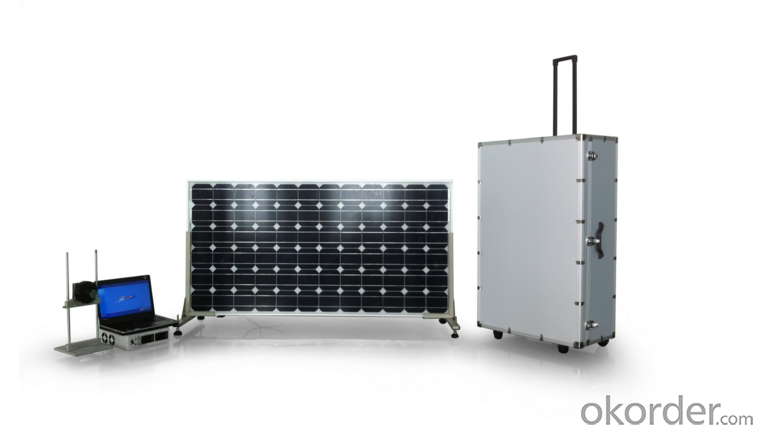
FAQ:
1. How long will my inquiry get response?
Your inquiry related to our products or prices will be replied within 24 hours.
2. Can I get professional service and suggestion?
Well-trained and experienced staffs to answer all your questions in fluent English.
3. Do you accept OEM or customized design?
OEM & ODM, any your customized lightings we can help you to design and put into product.
4. What if I need specific design?
Distributorship are offered for your unique design and some our current models.
- Q: Can a solar energy system be installed in areas with high winds?
- Yes, a solar energy system can be installed in areas with high winds. However, it is important to ensure that the system is properly designed and installed to withstand the wind conditions of the specific area. This may involve using strong and durable mounting systems, reinforced frames, and secure anchoring methods to ensure the panels and components remain stable during high wind events.
- Q: How do solar energy systems contribute to reducing noise pollution compared to traditional power generation methods?
- Solar energy systems contribute to reducing noise pollution compared to traditional power generation methods because they do not rely on mechanical components like turbines or generators that produce loud noises. Instead, solar panels convert sunlight directly into electricity, resulting in a silent operation. This absence of noise helps in creating a more peaceful and less disruptive environment for both humans and wildlife.
- Q: How does the efficiency of solar panels vary based on the temperature?
- Solar panels' efficiency is subject to variation depending on temperature. In general, solar panels perform better in cooler temperatures, but their efficiency declines as the temperature rises. This phenomenon is attributed to the materials used in solar panels, particularly semiconductor materials like silicon. As the temperature increases, the electrons in the semiconductor material gain more energy, resulting in a rise in the voltage output of the solar panel. However, this increase in voltage does not proportionally enhance the power output, leading to an overall decrease in efficiency. Furthermore, elevated temperatures can amplify the resistance of the electrical conductors within the solar panel, causing power losses and reduced efficiency. This is known as thermal losses. The heightened resistance impedes the flow of electric current, thereby diminishing the overall power output. In addition, high temperatures can trigger the "thermal runaway effect," a phenomenon where the efficiency of the solar panel rapidly declines as the temperature increases. This can pose significant challenges, particularly in regions with hot climates or during heatwaves. To counteract the adverse impact of temperature on solar panel efficiency, advanced solar panel designs incorporate cooling mechanisms. For instance, some panels are equipped with built-in ventilation systems or are elevated to facilitate air circulation underneath, ensuring dissipation of excess heat and maintenance of optimal operating temperatures. To sum up, solar panel efficiency is influenced by temperature fluctuations. While they perform better in cooler temperatures, their efficiency diminishes as the temperature rises due to increased resistance, thermal losses, and the thermal runaway effect. It is crucial to consider these factors during the design and installation of solar panels to maximize their performance and output.
- Q: Can solar energy systems be used in powering electric fences or security systems?
- Certainly, electric fences or security systems can be powered by solar energy systems. The conversion of sunlight into energy by solar panels enables the generation of electricity, which can be stored in batteries or used directly to operate different devices. This renders solar energy systems a feasible and sustainable alternative for powering electric fences or security systems, particularly in remote or off-grid areas where conventional power sources may not be accessible or dependable. Solar-powered electric fences effectively discourage intruders or confine animals within a specific area, while solar-powered security systems provide continuous surveillance and monitoring without the requirement of a constant electricity supply. Moreover, solar energy systems are eco-friendly and aid in reducing carbon emissions related to traditional power sources, thus becoming an increasingly sought-after and cost-efficient solution for diverse applications, including electric fences and security systems.
- Q: Can solar energy systems be used for powering agricultural irrigation systems?
- Yes, solar energy systems can be used effectively to power agricultural irrigation systems. Solar-powered water pumps are commonly used in agricultural settings to pump water from wells, rivers, or other sources for irrigation purposes. This renewable energy source helps farmers reduce their reliance on fossil fuels and lower their operational costs while ensuring a sustainable and reliable source of power for irrigation.
- Q: How does the installation of solar panels affect the roof's warranty?
- The installation of solar panels typically does not void the roof's warranty. However, it is important to consult with the roofing manufacturer and installer to ensure that the installation process does not breach any warranty conditions.
- Q: Can solar energy systems be used for powering mining or drilling operations?
- Indeed, solar energy systems have the capability to power mining or drilling operations. Given that these activities often occur in remote areas with limited access to grid electricity, solar power presents a practical and sustainable solution. On-site installation of solar energy systems can generate electricity to meet the needs of various mining and drilling operations, such as machinery, equipment, lighting, ventilation systems, and other power-intensive processes. Solar energy systems comprise solar panels that convert sunlight into electricity, which is then stored in batteries for use when sunlight is not available. This arrangement ensures a consistent and reliable power supply for mining and drilling activities, thereby reducing reliance on conventional fossil fuel generators or expensive grid connections. Moreover, solar energy systems offer numerous advantages for mining and drilling operations. They are environmentally friendly, as they do not emit greenhouse gases, thus lessening the carbon footprint associated with these energy-intensive processes. Additionally, solar power is a renewable energy source, guaranteeing a sustainable power supply for the long term. Although the initial investment in setting up solar energy systems may be higher compared to traditional energy sources, the long-term cost savings and benefits outweigh the initial expenses. Solar energy systems require minimal maintenance and have a lengthy lifespan, resulting in significant cost reductions over time. Furthermore, governments and organizations often provide incentives and subsidies to promote the adoption of renewable energy, further alleviating financial burdens. In conclusion, solar energy systems are a practical and efficient solution for powering mining and drilling operations in remote areas. They provide a sustainable, reliable, and cost-effective alternative to conventional energy sources, contributing to the reduction of environmental impact while ensuring a continuous power supply for these energy-intensive processes.
- Q: Can a solar energy system be installed on any type of roof?
- Solar energy systems can be installed on any type of roof, be it flat, sloped, metal, shingle, or tile. Options for solar installation are available for each type of roof, though the installation process may differ depending on the roof type. For instance, flat roofs may necessitate mounting systems that tilt the solar panels for optimal sun exposure, whereas sloped roofs may require adjustable racking systems to ensure proper alignment. Moreover, before installation, it is essential to assess the condition and structural integrity of the roof to ascertain its ability to support the weight of the solar panels. In conclusion, while the methods for installation may vary, solar energy systems can indeed be installed on any roof type.
- Q: Can solar energy systems be used in areas with frequent snowfall?
- Yes, solar energy systems can still be used in areas with frequent snowfall. While snow can reduce the efficiency of solar panels, it does not render them completely useless. Proper design and maintenance can help ensure that snow is quickly cleared from the panels, allowing them to continue generating electricity. Additionally, advancements in technology and the use of tilt mounting systems can also improve their performance in snowy conditions.
- Q: What is the impact of snow or ice on solar energy system performance?
- Snow or ice can have a significant impact on the performance of solar energy systems. Snow covering the solar panels reduces their ability to absorb sunlight and convert it into electricity. Ice can also create a barrier that prevents sunlight from reaching the panels. Both snow and ice can cause a decrease in the overall energy production of the system. Additionally, the weight of accumulated snow or ice can potentially damage the panels or the mounting structure if not properly addressed. Regular maintenance and snow removal are essential to ensure optimal performance and longevity of solar energy systems in snowy or icy conditions.
Send your message to us
Solar Energy Systems Nappanee Indiana Solar Portable System AN-S50W
- Loading Port:
- Shanghai
- Payment Terms:
- TT OR LC
- Min Order Qty:
- 0 set
- Supply Capability:
- 10000 set/month
OKorder Service Pledge
OKorder Financial Service
Similar products
Hot products
Hot Searches
Related keywords
